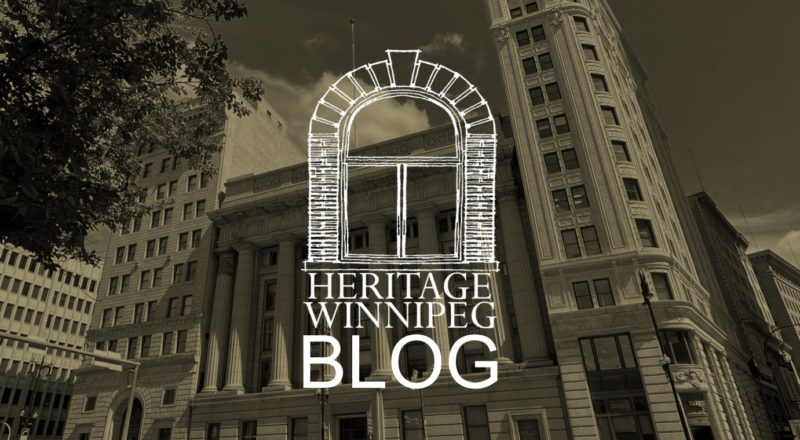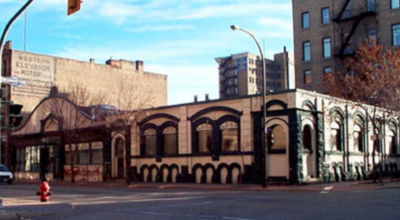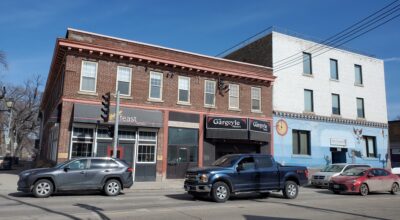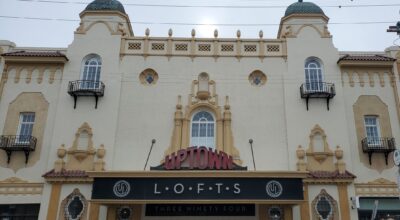
/ Blog
August 14, 2019
The Challenge of Change: The Reliable Service Station
Change is a challenging but inevitable fact of life. In a rapidly transforming world, adapting is the only means of remaining relevant. For heritage buildings, that means walking a fine line between conserving the past while constantly reinventing themselves to remain functional and vibrant. The building known to many Winnipeggers as the former Reliable Service Station at 98 Albert Street, is no stranger to this kind of evolution. Once a small, oddly shaped commercial building, over 100 years later it had become Bodegoes, a hip restaurant and patio in the lively Exchange District National Historic Site. In 2019 the building is undergoing a rather dramatic change, being demolished and replaced with a much larger modern structure. It is a change that has sparked a passionate debate as to how built heritage should be sensitively conserved and redeveloped.
Winnipeg in the late 19th century was a city flush with prosperity due to the arrival of the transcontinental railway. The Exchange District, well situated on the primary transportation routes of Main Street, the Red River and the railway line, was quickly developing from a haphazard collection of small buildings, both residential and commercial, into the warehouse district of the city. Main Street runs diagonally through the grid street system of the Exchange District, which was based on old river lots. With Albert Street being the only other street running parallel with this section of Main Street, it created an awkward intersection where Arthur Street and Albert Street collide as they arrive at Bannatyne Avenue. The resulting triangular piece of property is where the Reliable Service Station would come to stand.
In 1901 an irregularly shaped building was constructed on the triangular lot at 98 Albert Street, built to accommodate both the lot’s shape and the existing wooden house behind it. It was a long, narrow, single storey brick building with a shallow foundation of stone, covering about 1000 square feet and costing $800 to build. The building was divided into two shops, with the Maple Leaf Renovating Company in the south end and a paint and wallpaper shop in the north end. The paint and wallpaper shop was owned by W. J. Smith and Wilson McMaster, with Smith being the businessman who commissioned the construction of the building.
The building was home to various commercial operations until it was purchased by the Watson Tire Company around 1918, which converted it into a service station in 1919, specializing in batteries and tires. The service station eventually became known as the Reliable Service Station, catering to the new automobile industry. As more automobiles took to the roads, the Reliable Service Station expanded, taking over the house behind it by 1922. But this expansion did not change the awkward layout of the buildings, with very little space to serve customers on the northern tip of the property.
To amend this situation, the buildings had to adapt. In 1925, the house on the lot was demolished. It is speculated that the Reliable Service Station itself was not demolished but instead rotated about 90 degrees counter clockwise, so that the back of the building was abutting the tall building in the adjoining lot. Although there are no permits or reports indicating the movement of the building, it is noted that the new building was nearly the same size as the old one, had the same window and door configuration and the contractor that supposedly built the new building, the Boland Brothers, specialized in moving houses. Built on spread footings with no basement, it is completely plausible that is how the building still seen in 2019 came to be. Other have suggested that the building was not turned but the southern end of the original building was reused in the construction of the new building.
The “new” Reliable Service Station featured a service bay accessed from Arthur Street and two gas pumps sitting over tanks buried under the norther end of the property. Sitting on a reinforced concrete floor, the back wall of the building is actually the northern wall of the taller building it is sitting next to. The exterior of the building also received a facelift at this time, styled with white stucco walls and a mansard roof with red tiles. Based on the California Mission style that was popular for service stations in the United States, it was also a style used for Safeway and Piggly Wiggly buildings in Winnipeg.
The Reliable Service Station continued to operate at 98 Albert Street until the early 1970s, when changing regulations for gas stations and new, larger stations forced it out of business. The building then sat vacant for a number of years before the State Window and Building Cleaning Company moved in. After their departure in the 1980s, various other businesses used the space, eventually converting it into a restaurant with a patio. In 2000, Bodegoes took up residence, including space in the basement of the heritage building behind it. A staple tenant in the Exchange District that overlooked the redeveloped Old Market Square, it was a popular restaurant until its closure in October of 2017.
Bodegoes did not leave its Albert Street home willingly. The property was sold in 2016 and the new owners made plans to demolish the Reliable Service Station and redevelop the property. For many years the building had been protected from demolition as it was on the Inventory of Buildings under the old Historical Buildings By-law 1474/77. In 2014, the bylaw was changed, with 340 buildings suddenly and inexplicably disappearing from any list and losing their legal protection as historical resources. Fortunately, 98 Albert Street landed on the new Nominated List of Historical Resources, that protected it until it could be further evaluated. In December 2016, the Standing Policy Committee on Property and Development, Heritage and Downtown Development and the Historical Buildings and Resources Committee both recommended the building be added to the List of Historic Resources, protecting it from demolition and alteration of its character defining elements. It was noted that the building is a rare example of post World War I buildings in the Exchange District, built by a long time Winnipeg contractor, parts of the exterior were original and it was an integral part of an historic streetscape in a national historic site.
The recommendations were ignored by the Winnipeg Public Service, who after months of unexplained deferment of the issue, agreed with the building owner’s request and placed the Reliable Service Station on the Commemorative List of Historic Resources in April 2017. A completely meaningless list meant to placate heritage advocates, it allows building owners to appear as heritage supporters while they have zero obligation to respect the invaluable piece of heritage they have been entrusted with. This decision was exceptionally disingenuous, as it was made with the knowledge that there were plans to redevelop the site. The designation would have only impacted the exterior of the building, allowing great flexibility as to what could take place inside. If even this limited protection of features was too constraining for a redevelopment project to go forward, it seems to suggest that the Winnipeg Public Service was well aware that the new owners wanted to demolish the building and made sure to accommodate them. It is disgusting to think that invaluable heritage was purposely denied the recommended designation in the name of profit.
This report recommends that the resource not be added to the List of Historical Resources, but instead, that the Director of Planning, Property and Development add 98 Albert Street to the Commemorative List in order to support the redevelopment project.
As a result of this designation, in 2019 proposed plans for the redevelopment of the property were released, which unsurprisingly included completely demolishing the Reliable Service Station and building upon the northern tip of the property that has been open space for over 100 years.
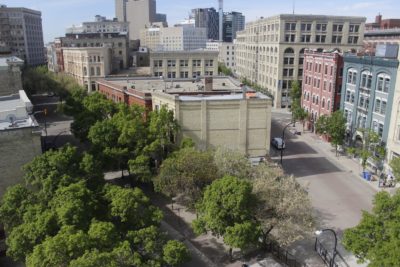
The streetscape of the Exchange District around the Reliable Service Station in 2019.
Source: Heritage Winnipeg.
Change is inevitable, even in historic neighbourhoods such as the Exchange District. In the early 20th century when the warehouses were bursting at the seams, additional storeys were often added to older structures. Yet if you were to walk by these buildings in 2019, you would be hard pressed to point out which buildings had additions built skyward. After many warehouses became vacant, they were later adaptively reused as offices, art studios, restaurants, residences and more, all without disrupting the historic integrity of the buildings. Because of this largely intact original historic streetscape and the role it played in the development of Winnipeg, the Exchange District was designated by the federal government as a National Historic Site in 1997. A vibrant, walkable, mixed use neighbourhood built on a human scale, it exemplifies all the best attributes of a well planned city. It has also become a popular location for filming, with the historic buildings being used as the backdrop for countless productions.
Aside from a strong outrage over the building being refused its rightful place on the List of Historical Resources, heritage advocates are also appalled by the building that has been proposed to take its place. Drawing on a strategy called “abstract reference”, the new building disregards its surrounding and instead juxtaposes it with a completely different architectural style. The resulting proposal is a ultra modern three storey building with a facade of glass and metal that is said to reference the brass foundry that is still standing at 90 Albert Street. The ground floor would house a restaurant while the upper floors would be “prestigious” residential units. Not only would the integrity of the historic streetscape be completely destroyed on a highly visible corner, but the development of “prestigious” residential units seems very out of touch with a city greatly in need of affordable housing in a very diverse demographic area.
“Abstract reference” has become a popular trend in architecture, with heritage guidelines often demanding a clear delineation between historic buildings and their modern additions. Why additions need to be so clearly marked as such is hard to understand. With modern record keeping practices it would be unlikely that future generations would be confused as to which part was original and which part was the addition. Even without much in the way of written records, historians still know that the Pantheon in Rome, built nearly 2000 years ago in the second century, was actually the third building on this site to go by that name. Even more specifically, they know that the Pantheon was built by Hadrian, not Marcus Agrippa, despite what the inscription on the front of the building states. Beyond the need for an accurate record of history, consider if you were building an addition on your house. Would you want a smooth integration between the old and new so that they appear to be as one, or have the addition stick out like a tasteless afterthought just because you did not anyone in the future to confuse the addition as being part of the original home? It is a senseless approach that creates disjointed streetscapes and buildings with no connection to their context.
The loss of the Reliable Service Station is inexcusable, but could have been far more tolerable if it were replaced with a building that was in harmony with its surroundings. Referencing a building that is still standing as opposed to one that is being demolished seems to be an odd choice, while completely ignoring the significance of keeping the surrounding historical streetscape intact is deplorable. Buildings do not stand alone, they are part of a larger context that needs to be carefully considered to ensure a smooth integration. And if 1000 years from now historians cannot tell which buildings are original and which are later additions, bravo to the architects and builders who accomplished such a feat!
THANK YOU TO THE SPONSOR OF THIS BLOG POST:

Written by Heritage Winnipeg.
SOURCES:
98 Albert | AtLRG Architecture
Bodegoes to close its doors | Gina Contreras - October 26, 2017 - The Projector
Exchange District National Historic Site of Canada | Canada’s Historic Places - Parks Canada
Pantheon | History.com Editor - January 31, 2018 - History.com
Reliable Service Station | Virtual Heritage Winnipeg
Stand! Movie | Stand! Movie - December 16, 2018 - Facebook
State Window Cleaning Building Report | City of Winnipeg
When old meets new | Brent Bellamy - April 15, 2019 - Winnipeg Free Press
Winnipeg’s preservation puzzle | Kevin Rollason - August 9, 2019 - Winnipeg Free Press





